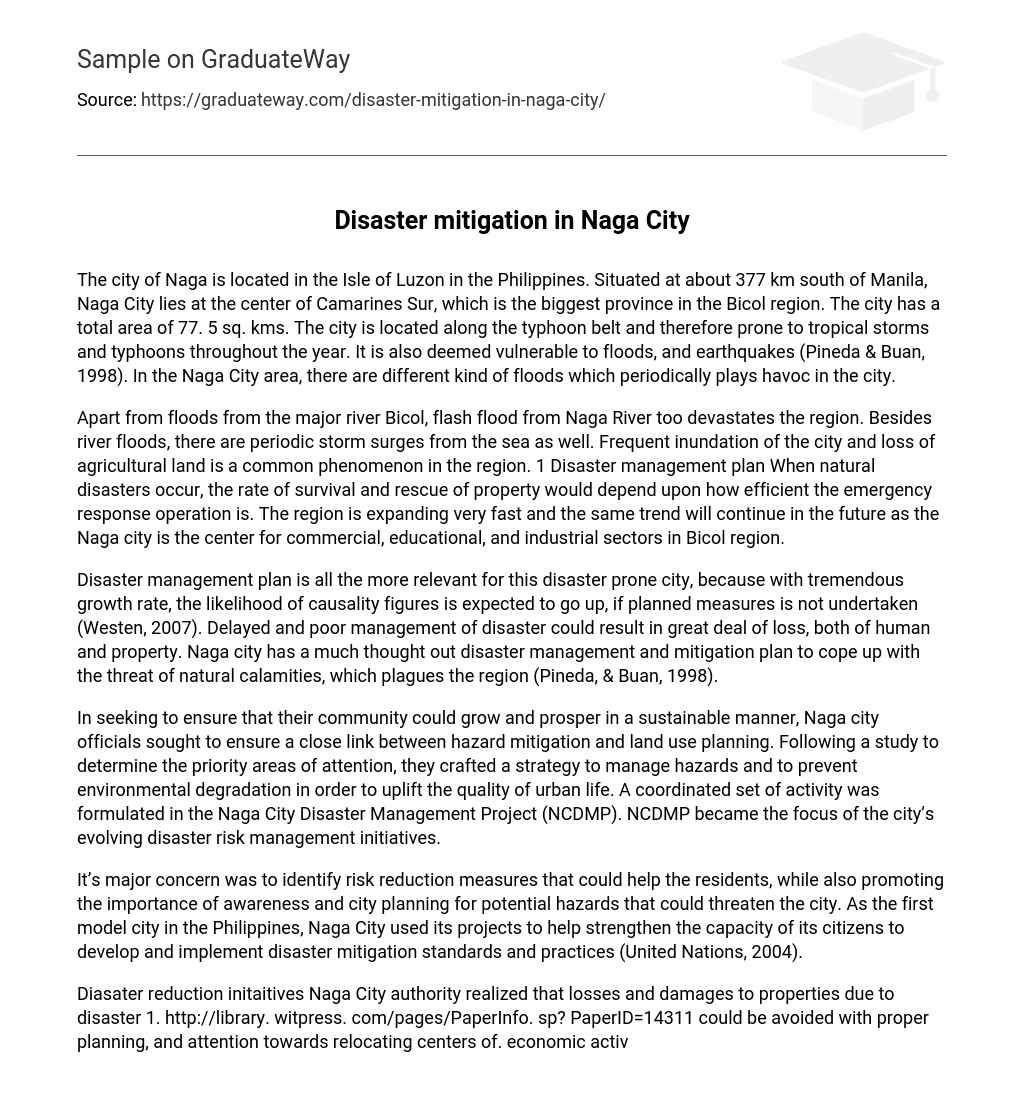The city of Naga is located in the Isle of Luzon in the Philippines. Situated at about 377 km south of Manila, Naga City lies at the center of Camarines Sur, which is the biggest province in the Bicol region. The city has a total area of 77. 5 sq. kms. The city is located along the typhoon belt and therefore prone to tropical storms and typhoons throughout the year. It is also deemed vulnerable to floods, and earthquakes (Pineda & Buan, 1998). In the Naga City area, there are different kind of floods which periodically plays havoc in the city.
Apart from floods from the major river Bicol, flash flood from Naga River too devastates the region. Besides river floods, there are periodic storm surges from the sea as well. Frequent inundation of the city and loss of agricultural land is a common phenomenon in the region. 1 Disaster management plan When natural disasters occur, the rate of survival and rescue of property would depend upon how efficient the emergency response operation is. The region is expanding very fast and the same trend will continue in the future as the Naga city is the center for commercial, educational, and industrial sectors in Bicol region.
Disaster management plan is all the more relevant for this disaster prone city, because with tremendous growth rate, the likelihood of causality figures is expected to go up, if planned measures is not undertaken (Westen, 2007). Delayed and poor management of disaster could result in great deal of loss, both of human and property. Naga city has a much thought out disaster management and mitigation plan to cope up with the threat of natural calamities, which plagues the region (Pineda, & Buan, 1998).
In seeking to ensure that their community could grow and prosper in a sustainable manner, Naga city officials sought to ensure a close link between hazard mitigation and land use planning. Following a study to determine the priority areas of attention, they crafted a strategy to manage hazards and to prevent environmental degradation in order to uplift the quality of urban life. A coordinated set of activity was formulated in the Naga City Disaster Management Project (NCDMP). NCDMP became the focus of the city’s evolving disaster risk management initiatives.
It’s major concern was to identify risk reduction measures that could help the residents, while also promoting the importance of awareness and city planning for potential hazards that could threaten the city. As the first model city in the Philippines, Naga City used its projects to help strengthen the capacity of its citizens to develop and implement disaster mitigation standards and practices (United Nations, 2004).
Diasater reduction initaitives Naga City authority realized that losses and damages to properties due to disaster 1. http://library. witpress. com/pages/PaperInfo. sp? PaperID=14311 could be avoided with proper planning, and attention towards relocating centers of. economic activity and settlements in safer areas. Through the development of community based surveys, with technical data provided by the weather service flood forecasting division, hazard mapping was carried out. In their planning for disaster risk reduction measures, the local authorities maximized the use of GIS. GIS also helped them determine which areas of the city would most likely become flooded. Accordingly, city officials targeted specific households for evacuation.
After the identification of the vulnerable areas, the Naga City local authority made plans to shift the economic activities from low lying flood prone areas to elevated and less risky areas of the city. The local authority promulgated a five year developmental plan, whereby new land use laws and economic incentives have been made and new areas have been developed into growth centers. Coping strategy after Durian Durian is the fourth typhoon that hit Philippines within a span of three months. Worst hit by the typhoon was the areas near Mayon volcano, located at the south east of Manila. The typhoon wrecked havoc in Camarines, Sur, Albay, and other provinces in the region.
Termed as super typhoon, it submerged the provinces of Albay, and caused several villages near the Mayon volcano to be completed buried due to mudflows and landslides. Immediately after the typhoon, the Provincial Disaster Coordination Council (PDCC) together with pertinent agencies, and individuals initiated relief operations on war footing for the affected families. The persons affected by flood were moved to the evacuation centers and essentials and food items were distributed in a coordinated manner.
The Provincial office along with regional center for health development coordinated the work of vaccination, drinking water testing, regular health assessment, deployment of environmental health sanitation team, and needed supplies of essentials and medicines. Rehabilitation of water and electricity infrastructures was implemented with speed and efficiency. 3 Conclusion The typhoons in Philippines in 2006 wrought havoc in Naga City and nearby areas. The massive destructions caused by these typhoons were an eye opener for the authorities. The government has leant a lesson, albeit in a bitter way.
Precautionary measures have been taken now on a massive scale, and not later. The typhoon Durian in Philippines could have caused less causality if there were timely intervention of the authorities to move the people of flood prone area to safer elevated area. As there is the possibility of disasters happening any time, people near the Mayon volcano have been shifted several times right after the warning of some impending disaster, which is perhaps the only way to prevent causality and loss of property. In this the city has set an example.





